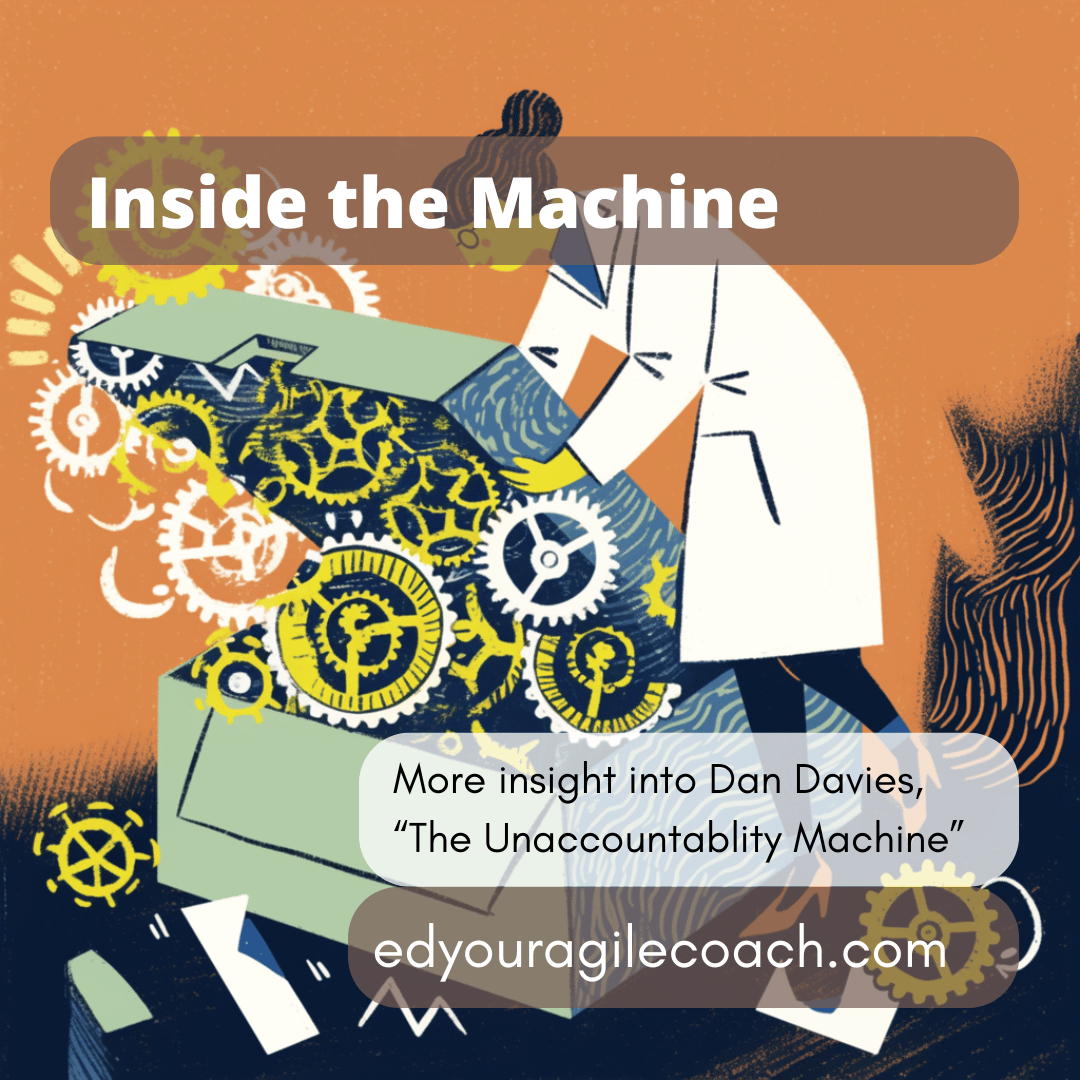The gears of the Unaccountability Machine

Last week, I devoted my blog to Dan Davies's book "The Unaccountability Machine." I consider it a must-read for anyone involved in consulting and change management. While it is easy to read and breezy, like two professional people chatting over drinks, it contains many essential concepts that should inform change adoption. It has so many great ideas that I could not summarize them in one blog post. Today, I will cover cybernetics and how to look at your organization from its perspective.
When we hear cybernetics, most think of a particular science fiction genre. These are high-tech worlds filled with low-life gangsters doing violent things for money, pride, or data. In the film Johnny Mnemonic, Keanu Reeves captures the tropes and aesthetics that made the genre popular over the last forty years. Unfortunately, cybernetics by Dan Davies and Stafford Beer refers to the study of control systems. As systems get more extensive and complex, it becomes essential to understand better how they can remain stable or fall apart.
Davies points out that Stafort Beer loved visualizations and charts. Many of his original books contain complex drawings explaining systems. This visual way of looking at organizations makes describing how these systems operate in writing difficult. Davies devotes two chapters to explaining Beer's ideas, and I will try to summarise them for easy reference. Most organizations are composed of five systems, which are either formal or informal, but every organization has these systems.
The first system, System-1, represents people changing the external world. These people are the store salespeople, musicians in the orchestra, and ticket clerks at the airport. Each day, these people low on the organizational chart interact with customers and clients, providing the goods and services that generate value for the organization.
People in System-2 support the people in System-1. If you've got a team on a mission, they've got to work together smoothly. Someone needs to set up the work schedule. You've got to train everyone so they know what they're doing and give them the right tools to do it. System-2 people are often schedulers, human resources professionals, and quartermasters.
If everything stayed the same and nothing changed, we would not need the following three systems. Still, global business moves so quickly that they are necessary for the successful operation of the firm. System-3 people represent traditional managers. Davies says the mission of these people is to "coordinate activities towards a particular purpose." System-3 people are about achieving a purpose or goal, whether reducing defects on an assembly line, meeting sales goals, or finding enemy soldiers and killing them. It is the home of traditional management and leadership.
Management focuses on the immediate needs of the organization and its mission. That is why you have gloves for sale during winter at a department store and cargo shorts in the summer. System-3 people respond to immediate changes and make sure that people in System-2 and System-1 work together to meet the organization's goals. Unfortunately, they do not respond well to change outside their immediate contact. The System-4 people manage that responsibility. If someone is analyzing data, studying changes to regulations, or working on alternative suppliers for the business, they are doing System-4 work. As Beer says, System-4 people gather information from the environment, which System-1 does not usually contact. Bankers, legislators, and scientists often collaborate with System-4 people to provide them with the specialized knowledge to deal with significant changes. System-3 and System-4 people collaborate to ensure the organization can deal with changing conditions over time.
The final group ensures that System-3 and System-4 work in harmony and represent the executive and ideological portion of the firm, known as System-5. An orchestra that performs modern symphonic music will be very different from one that plays background music for Elton John. System-5 is powerful because it acts as the organization's identity and provides 'self-creation.' To understand this in practice, compare Microsoft's operations under Steve Ballmer and then under Satya Nadella.
Under Beer's theories of cybernetics, an organization must have systems one through five that work to keep it viable. As an organization grows in size and complexity, these systems clump together into nodes or information, such as Gilles Deleuze and Felix Guattari's Rhizome. These modes then share information from the front-line employees to the CEO and Board of Directors.
Now that we understand these cybernetic systems in an organization, Dan Davies outlines his toolkit for understanding how large organizations should operate. They are:
- There are five core functions; if any are missing or under-resourced, the flow of information won't be balanced with the capacity to process it.
- Information only counts if it is being delivered in a form that can be translated into action, meaning it needs to arrive quickly enough.
- Systems preserve their viability by dealing with problems as much as possible at the same level they arrive. Still, they also need communication channels that cross multiple levels of management to deal with big shocks that require immediate change.
So now we understand the parts of cybernetics that act like gears in a watch and the rules that move those gears to diagnose problems in large organizations. For instance, are System-3 people micromanaging System-1 people because they do not trust them? What happens when System-2 people change the scheduling system? When layoffs impact the organization, are System-4 and System-2 people impacted disproportionately? Having honest answers to those questions will help spot organizational dysfunction and provide suggestions for change.
Understanding how those diverse systems work together is critical to impacting organizational change. Next time, we will examine how a significant change in System-5 thinking and the hollowing out of System-3 and System-4 is the source of our current problems in corporate organizations.
Until next time.




Comments ()